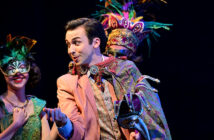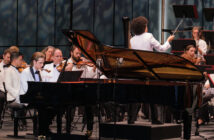RETROSPECTIVE: of Opera Saratoga’s 2017 Summer Mainstage Season (July 1 through 16) – Verdi’s Falstaff; Grétry’s and Marmontel’s Zémire et Azor; Blitzstein’s The Cradle Will Rock.
The end-days of summer are high horse-racing season in Saratoga, with turfites and extravagant millinery abounding; but, while much of the city lives for the thrill of beating hooves, Saratoga’s culture caters broadly. For many, summer’s highlight was long before a single bay bolted its stall, and the city swayed to different beats entirely – the two-week July mainstage season at Opera Saratoga.
This year’s performances ran from July 1 through 16.
Save the Dates!
It’s an admittedly compact calendar (blink and you might miss it), but it’s embraced by a thronging and enthused local constituency, plus opera wayfarers from an increasingly wide swath of the States and beyond.
The company has an estimable pedigree, dating back to a founding as Lake George Opera in 1962. But, since his appointment in 2014, artistic and general director Lawrence Edelson has palpably transformed and quickened the organization, coaxing from the chrysalis of institutional history an even brighter and more robust new organism.
The conclusion of Edelson’s third full season brings plenary proof of concept for this nimble, adventurous midcap summer cultural enterprise, thriving and continuing to grow, and having put three more notable productions in its pocket.

Quickly (Lindsay Ammann), Meg Page (Vera Savage), Nannetta (Emily Tweedy), Alice Ford (Caroline Worra), Photo: Gary David Gold
Magic, Handled by a Master
First up this year was a thoroughly engaging production of Giuseppe Verdi’s glorious comic magnum opus, Falstaff (performed July 1, 6, 10 and 15; viewed here July 15). Derived from Shakespeare (principally from The Merry Wives of Windsor, augmented by a soupcon of elements from the Henry IV plays), with an Italian libretto by Arrigo Boito, this is a work of astonishing verve, buoyancy, and variety.
Falstaff is Verdi’s last work for the opera stage and, cognizant as he was of its summary place in his catalogue, the maestro rose to the occasion with a score that positively dazzles. One hears here an artist both consummately mature and confident in his craft and, at the same time, as unfettered as a young buck intent on kicking over even his own traces. There is uniquely, truly funny music here, side by side with passages of plangent and elegiac caress, touches of piquant irony, and episodes of moving, autumnal introspection.
Premiering as it did in 1893 – the horizon of a new musical century nearly in view – Verdi summoned experimental gestures and harmonic novelties that commentators view as looking far forward, well beyond Wagner, to composers such as Richard Strauss (who called Falstaff “one of the greatest masterworks of all time”), Benjamin Britten, and others.
Make Way for the Big Man
“It’s a big opera for us to be doing in a small space,” remarked Edelson after the opening, mindful of the intimate dimensions of the company’s Spa Little Theater home base. But director Chuck Hudson turned any logistical challenge to full advantage.
Indeed, as more and more characters were required for the onstage action, principals seemed to recruit extras and choristers right out of the audience, impressing them into service and lending them mere fig leaves of period dress (a hat, a cloak) to comport with the main Elizabethan design (an effective unit set by Martin T. Lopez, costumes by CeCe Sickler, and lighting by Brandon Stirling Baker).
And while these supernumeraries were no doubt plants, the packed stage lent a bubbly, teeming, shambolic charm that was also thematically apt. Falstaff himself is, after all, an overstuffed man. But his size is more than mere adipose and appetite run amok. He’s a character fairly gorged on self-deception and false self-esteem, a man quite visibly full of himself.
That’ll Teach You
The story revolves around the rotund knight’s attempts to woo – for financial gain – not one but two wealthy and reputable local matrons, Mistress Ford and Mistress Page. These two witty ladies, however – as well as nearly everyone else in the neighborhood, except for Mistress Ford’s jealous and credulous husband – are onto the game. They conspire to lead Falstaff on toward an eventual one-two punch of humiliation – first, via a dunking in the local river amidst a profusion of dirty laundry; and, later, through an even more harrowing nocturnal gauntlet amidst a masquerade of forest fairies, ghosts, and assorted folkloric terrors.
The Saratoga production nailed precisely the contrast of tone and structure between the opera’s first two acts and its third – the former a brilliant inversion and sendup of the Don Giovanni mythos (would-be seducer as hapless dupe rather than charismatic sociopath); while the gossamer mysticism of Act III played almost like a secular (or, dare one say, “paganized”?) high mass, Falstaff as sacrificial victim amidst a crepuscular passion play.
And that concluding chorus! – an awesome, rollicking fugue that cements the sense of comic sacramentality, a virtual parody of a baroque choral amen.
The Windsor Crowd
The performances were uniformly commendable. Tenor Dominick Corbacio and soprano Emily Tweedy were delightful and fine-voiced as the young lovers, Fenton and Nannetta, providing just the right romantic counterpoise to the farcical pillorying sustained by the title character. Soprano Caroline Worra, mezzo-soprano Vera Savage, and mezzo/contralto Lindsay Ammann as, respectively, Mistresses Alice Ford and Meg Page and their co-conspirator Mistress Quickly were an exquisitely blended and brilliantly earthy trio of resourceful comic Furies wreaking havoc on Falstaff’s delusions of virility.
Baritone Michael Chioldi was ideal as the hot-blooded landholder Ford. His masterfully seething performance of the jealousy aria, “È sogno o realtà?,” in which he fatuously question his steadfast wife’s fidelity, was exquisite. One was fully persuaded that this was Verdi having raided his own trunk, repurposing something he might well have drafted for Otello, then pitching it down a fach.
Finally, bass-baritone Craig Colclough, as Sir John Falstaff, was an endless delight. Colclough managed to beguile every measure of ponderous warmth, preposterous didacticism and unctuous libido out of the oversized vocal life of the character, and proved an ingeniously subtle and inventive comic actor in his mounting of this living monument of a buffoon – infuriating, gelastic, grotesque, and ultimately quite vulnerably, lovably human.
Conductor Craig Kier was on top of a complex and challenging score, bringing all its requisite color, bounce, chiaroscuro and fun to the fore, abetted by an accomplished corps of instrumentalists.
From Z to A…
Also on the 2017 Opera Saratoga stage was Zémire et Azor, which tells the tale better known to all as “Beauty and the Beast.” (Opera Saratoga presented the work three times, July 2, 8 and 14; viewed here at the July 14 closing).
It’s a gem-studded 18-century musical rivière of a work, termed not an “opera” but a comédie-ballet mêlée de chants et de danses by its Belgian composer, André Grétry. With a libretto by French philosophe (and Freemason) Jean-François Marmontel, it was first presented in 1771, and is reputed to have been among Mozart’s favorite works (a copy of the score was found among Mozart’s things after his death). It still enchants with an oddly alluring combination of cool surface elegance, fairytale charm, and deft balance of romance against menace. Indeed, while Zémire et Azor could appear at first glance a mere children’s opera, it broods like the tales later collected by the Brothers Grimm with a hint of aphotic mystery below the storybook simplicity.
Beauty’s Long Shadow
One can readily understand the appeal of Zémire et Azor for Mozart the Mason – perhaps, arguably, even discern in it certain anticipations of elements that he and his own collaborator, Emanuel Schikaneder, would later use in their 1791 Die Zauberflöte: mysterious yet benign airborne creatures on which mortal characters hitch a ride; the gradual penetration of a haunted space (Azor’s palace in the earlier work, the palace and temple of Sarastro in Mozart); daunting challenges; mystical transformations; beastly aggressions against chastity; birds!
The story is instigated by the shipwreck of a rich merchant, Sander, on an unknown shore, and his subsequent providential discovery of a seemingly deserted palace. There, Sander and his servant, Ali, are treated to food and wine by unseen sprites – supernatural minions, as it turns out, of the palace’s chief resident, the grotesque beast Azor. Having unwittingly accepted the monster’s hospitality, Sander then inadvertently traduces it – by picking a single rose to bring home to his favorite daughter, Zémire.
The beast is outraged, and presents the merchant with a veritable Sophie’s Choice of a dilemma: death for Sander and his entire family, or surrender of the maiden Zémire to be Azor’s paramour.
The merchant’s anguish is palpable, but the selfless Zémire insists on making the sacrifice. Her first encounter with the beast is chilling (not least due to the eerily dulcet understatement of the music with which Grétry accompanies it), but the upshot can be guessed at – revulsion recedes, affection blossoms, roses regenerate, a punitive bewitchment is lifted, and a mortally reconstituted Azor is disclosed, with happiness following ever after.
Still, one cannot shake a certain discomfiting intrigue with the depth perversities and challenging latencies here: the allure of the bestial; sacrifice of the innocent; supernatural immanence. It’s all susceptible of multiple and conflicting interpretations, from the nihilistic to the Manichaean to the Christian-allegorical. Yet director/designer James Ortiz avows in program notes to have mounted the production “without irony,” which effectively leaves the acute and haunting aftereffects of the production for each to grapple with on his own.
Building the Beast
Ortiz’s physical production was terrific. The unit set was lovely – and mechanically ambitious – replete with Disneyesque castle and a big central turntable that transited the action fluidly between interior and exterior, palace and merchant’s home.
Ortiz’s crowning constructivist triumph, however, was the beast Azor himself: a puppet behemoth of astonishing expressivity, very much alive, if less animal than mineral, with its ornamented and burnished coppery finish suggestive, perhaps, of some Transformers period-remake. This strangely beautiful Michael-Bay-meets-Jean-Cocteau excrescence was animated by a wondrously synchronous team of four puppeteers concealed in and behind its limbs and thorax.
Each role was sung and acted with superlative good taste, good voice, and behavioral finesse. Baritone Christopher Burchett played the merchant Sander with rich musicality and mellow warmth, while tenor Keith Jameson played the merchant’s manservant, Ali, with an admirably flexible vocal instrument and a characterization of pitch-perfect comic fecklessness.
Two members of the Opera Saratoga Yong Artist Program, soprano Lisa Rogali and mezzo-soprano Katherine Maysek, played, respectively, Sanders’ two other daughters, the vain and flighty Fatme and Lisbe. Both performers offered pert, preening delight and evinced clean mastery of the sprightly yet demanding vocal lines with which Grétry’s score tasks them.
As the heroine Zémire, soprano Maureen McKay was enchanting. Possessed of a natural grace, an infectiously beaming smile and a voice of unalloyed silver, McKay aced the challenge of achieving actual chemistry with the terrifying animated construct that was her principal stage partner for the lion’s share of the performance. And her negotiation of the florid hazards in the famous birdsong, “La fauvette,” was pure magic.
Finally, Andrew Bidlack, as the voice and soul of Azor, was an utter knockout. The rich, mature and luxurious chiaroscuro of Bidlack’s tenor endowed the beast with a constant and invaluable fascination – a masterfully sustained mix of menace and tragic pathos. Outfitted in a glamorously sinister capuchin monk’s robe and hood, Bidlack stalked stairways and side platforms as he gave voice to the animated Azor puppet center stage, and the effect was stunning – a mesmerizing, split-screen/simulcast, as it were, of both the creature’s grotesque exterior, and the passionate, shrouded soul within.
While sung in French, the production featured passages of fleet, efficient, operetta-style English dialogue bridging numbers. Bidlack, speaking as Azor, was particularly effective, conveying angsty authority tinged with just the right note of vulnerability.
A sizable portion of Zémire et Azor‘s score is devoted to dance (the production was, indeed, this season’s installment of Opera Saratoga’s ongoing “Opera-in-Motion” series), and the corps of dancers assembled for this production – Hannah Button, Sean Anthony Jackson, Alex Mace and Hanna Zinn – were exemplary, both as the balletic specters attending at the beast’s palace, and as puppeteer animators of the beast himself. The choreography was by the inventive and skilled Jill Echo.
Conductor Lidiya Yankovskaya admirably wangled both the noble and the nimble out of Grétry’s sophisticated, glittering, evocative score.
Back to the Cradle
Most widely discussed in advance of this Opera Saratoga season was the company’s planned production of composer-librettist Marc Blitzstein’s controversial, idiosyncratic – and surprisingly fun – 1936 proletariat-boosting agit-opera, The Cradle Will Rock (a project earlier previewed here, and performed four times at Opera Saratoga: July 9, 11, 13 16; viewed for this writing at the July 9 opening). It’s a work with near universal name-recognition among operatic and musical-theater cognoscenti, but one never seen or heard as it would be here.
The warrantable buzz and excitement mostly concerned plans to present Cradle, for the first time in memory, with both its full, original Blitzstein orchestrations (piano accompaniment has been the longstanding norm) and fully staged (as opposed to rendered in a “presentational,” cantata style, adopted even for the Howard da Silva-directed “bleachers” production at New York City Opera in 1960).
The plan did not disappoint.
The monitory fable of Steeltown U.S.A., corrupted at every social level by the predations and capitalist cupidity of its boss-man, “Mister Mister,” was brought to full, sometimes fierce, sometimes tongue-in-cheek life in Lawrence Edelson’s colorful, high-energy production.
Some standout performances in a large and uniformly well-cast ensemble were mezzo-soprano Ginger Costa-Jackson as the Moll, Blitzstein’s original model for the downtrodden victim of the system, forced into prostitution in order to survive. Often conceived as more wan and passive than here, Costa-Jackson instead brought Black-Dahlia exoticism and gorgeous, smoldering vocalism to the role. She was thoroughly engrossing right from her opening musical soliloquy.
Baritone Christopher Burchett brought power and vivid blue-collar conviction to his turn as everyman Larry Foreman, Blitzstein’s essential protest-voice conscience of The Cradle Will Rock.
Equally well-acted and vocally impressive performances were offered by baritone Efraín Solís as the hapless and corrupt officer Dick; bass-baritone Justin Hopkins as the fire-and-brimstone pharisee Reverend Salvation; tenor Keith Jameson as the bedeviled Harry Druggist; bass Matt Boehler as the evening’s arch-antagonist, Mr. Mister; and mezzo-soprano Audrey Babcock as his willfully benighted facilitator, Mrs. Mister; plus a tapestry of additional colorful characterizations by members of the Opera Saratoga Young Artist Program.
Opera Saratoga artistic and general director Lawrence Edelson directed and choreographed the production with flair. His hilarious coup de théâtre of having the corrupt Steeltown “Liberty Committee” – whited sepulchers to a man – appear at the eleventh hour in whored-up red stilettos and forming a makeshift chorus line/police lineup was both a perilously edgy meta-commentary, and a perfect correlative to Blitzstein’s originating inspiration for The Cradle Will Rock. , It was no less an oracle than Bertolt Brecht who had offered Blitzstein the seminal suggestion: “Why don’t you write a piece about all kinds of prostitution – the press, the church, the courts, the arts, the whole system?”
The great John Mauceri conducted the recovered treasure of Blitzstein orchestrations with masterful insight.
Pack That 2018 Saratoga Trunk
In addition to their July mainstage season, Opera Saratoga offers other educational and outreach programming throughout the year, including children’s opera and concert entertainment for seniors. And, like all the best post-millennium curators of the operatic tradition, Edelson and his colleagues eschew hidebound notions of canonical hierarchy or strict genre definitions in choosing their material, favoring condign proportions of heart and brain, Old-World and New, the novel and the neglected, the revelatory, the august and the offbeat.
The company’s 2018 mainstage season will mark an important programming expansion, moving up from three full productions to four, and including two important premieres. The announced lineup comprises Franz Lehár’s golden operetta, The Merry Widow; Gian Carlo Menotti’s The Consul (the prolific composer’s potent first full-length opera); the American premiere of Rocking Horse Winner, with music by Gareth Williams and a libretto by Anna Chatterton; and the chamber version world premiere of Vinkensport, or The Finch Opera, with music by David T. Little and a libretto by the near-ubiquitous opera wordsmith Royce Vavrek.
Additional information is available at www.operasaratoga.org.






















